|
Holy
Roman Empire Impressions |
|
|
|
ARMOUR
This list is not all-inclusive, but gives a good
idea of the style of this impression. |
15th
Century Man At Arms of the Holy Roman Empire
For
this purpose, Man at Arms shall denote any foot combatant,
of higher station or rank.
Fu▀knechte denotes any foot soldier,
the normal rank and file.
Required
initially is the helm, correct clothing, and appropriate
weapon, the halberd. |
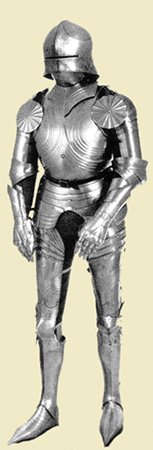
| What
epitomizes the Gothic era from those previous is the fluting,
or raised lines added to the surface of armour. These
lines, though extremely fancy by now, the High Gothic Era,
are for more than show. Raises in the armour like this
actually strengthen the armour. This allows lighter
steel to be used in the construction, making the armour more
comfortable for the combatant.
|
Below
are prime examples of the bits of a kit for someone portraying
a soldier living in the Holy Roman Empire around the 1470's.
Section
1: Helms; being of head protection for the soldier. |
The
Schaller
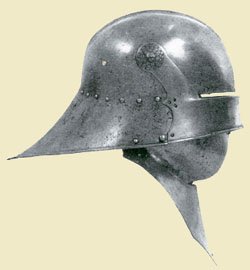
Expensive
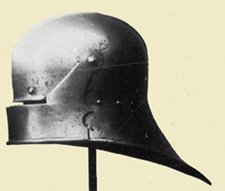
Expensive
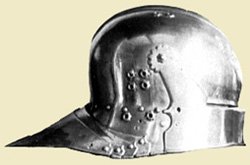
Expensive
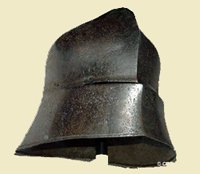 |
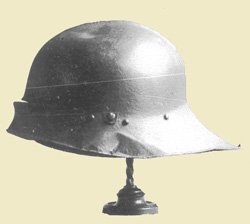 Munition-grade Munition-grade
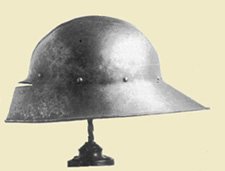 Munition-grade Munition-grade
The
Schaller is a helm designed to protect the head with varying
functions. Usually equipped with a visor that retracts,
it affords the wearer protection for the face when needed,
or the air preferred when appropriate.
The
tail of the helm may or may not be equipped with Lammes,
or a "lobster-tail" section of folding plates
that allow movement; in this case, allowing the head to
swivel upward. Lammelar construction became very
common in the 1480's and was only mostly seen on expensive
helms during the 1470's.
Covering
only half of the head, it was designed to be employed
with a Bevor, or neck guard. The Bevor is a Gorget
with lower face protection added on. Most often
Bevors were made with lammes as well, allowing the plates
to fall, allowing for more air.
The
helm was the most important item in a soldier's inventory
and it was common for simple foot-soldiers to purchase
expensive Shallern if they could.
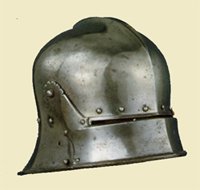 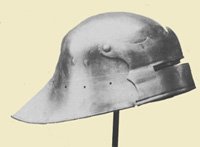
Expensive
Munition-grade
|
|
Flemish
Sellet
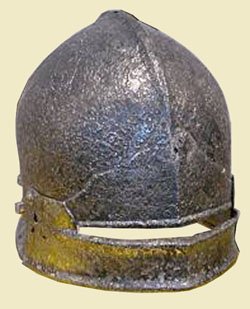
|
This sallet (The generic term for a Schaller, or Celata)
is a Flemish excavation piece.
The brow reinforcement looks to be only decoration preened
into the crown of the helm, or a separate wall of steel
riveted to the crown. Either way, the visor may
be fixed and not movable or only marginally movable.
|
Burgundian
Sallet
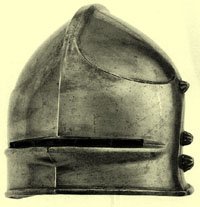
|
The Burgundian Sallet is identified by perhaps its medium
protection offered by the visor if produced in Flemming,
or a full German-style deep-visor as replicated in Italy.
Another indication of a Burgundian Sallet is its large knob-like
decorative rivets. |
|
The
Celata
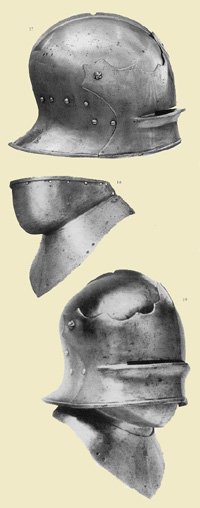
|
The
Celata is like the Schaller, only made to Italian style.
Italy also worked hand-in-hand with German arms and armour
makers to export munitions-grade versions of popular equipment.
An Italian export Sallet is distinguished by its extremely
short tail with no lammels, that is upturned at the very
end point as on the model here.
The
German-style deep-visor is present on many Italian exports.
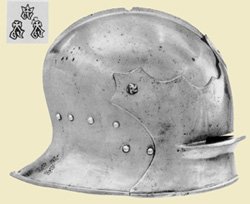 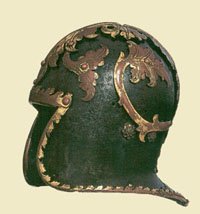
|
The
"Black Sallet"
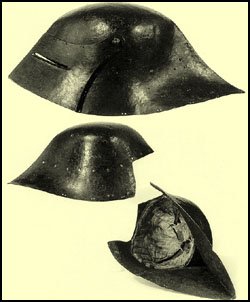 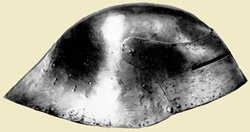 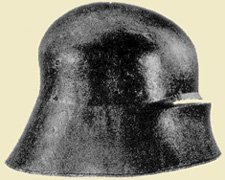
|

Common
for soldiers lacking of funds to acquire a well-built
sallet, or soldiers like those in the artillery, with
little need for the best front-line equipment, the "Black
Sallet" saw service all over the Empire by foot soldiers
in every line of duty. Referred to as the "Black
Sallet" by its characteristic black color that came
from the forge it was made in and its lower quality steel,
rich in iron-ore. The hammer marks and other smudges
of its creation are not smoothed out and the sallet is
given a thorough burning in the forge, preferring a black
color. Styles varied from a simple helmet shell
as above to intricate visored version as to the left.
The
helms were usually colored by artists or the soldier themselves
with bold designs ranging from crude drawings to fancifully
made glyphs and symbols displaying the soldiers affiliation,
or job among the Kompanie. Often Ensigns or "best
Boys" would take to these sallets, favoring the bold
nature of richly colored designs to the standard satin
finish of all other armours.
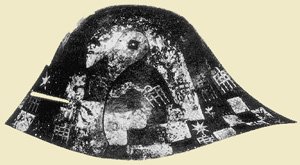 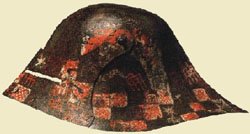
|
"Shooter
Sellets"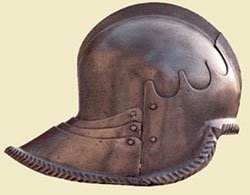
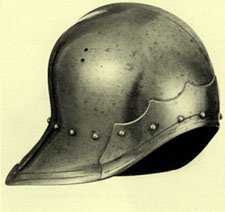
|
Left
is an Italian "Shooter" Celata. The term
"shooter" is meant to be applied to any projectile
soldier, be they crossbowmen, archers, or gunmen. Sallets
for bowmen or gunmen were open in the face and often had
a tail for protection to the neck, due to the fact that
they would hide behind a free-standing shield to reload
and often could not see incoming blows that might strike
there as they look down on their weapon.
This
type of helm was more common in England and Germanic forces
tended to use the Eisenhut if not a Schaller.
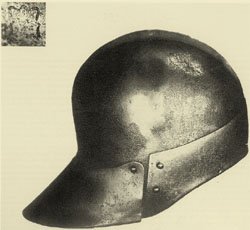 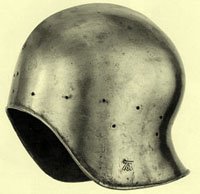

|
Eisenhut
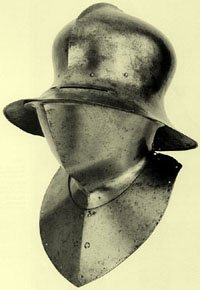
|
This
German variation of the Kettle Hat. The rim of the
hat is extended downward to cover the nose and eye-slits
are cut from around the top of the rim.
The
arming hat gives a lot of vision and air to the wearer
and is favored by soldiers on foot for these privileges.
The rim is brought low around the face in an effort to
give adequate protection to the head.
The
protection of the Eisenhut was also optimized when employed
with a Bevor.

|
Bevor
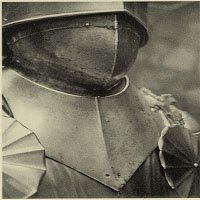 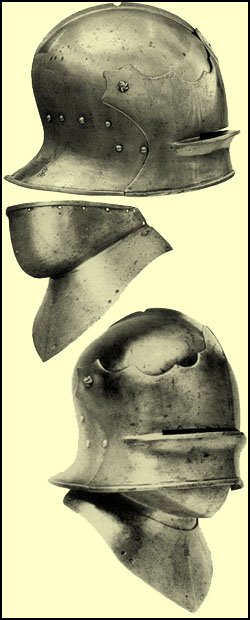
|
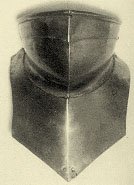
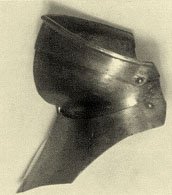
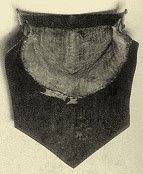
The
Bevor is protection for the lower half of the face.
It is strapped down to the top of the breastplate and
secured behind the back of the neck or head.
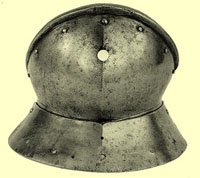 
|
|
On
to Section 2 of Holy Roman Empire Impressions |
|
On
to Weapons of the Empire |
|
|
|
|